At last, a sensitive rugged, reliable, low-maintenance way to measure rainfall.
The RG-11 Rain Gauge counts the number and size of the drops hitting the sensing surface. The algorithms within the RG-11 interpret this data and produce the same sort of output produced by a tipping bucket style rain gauge. The RG-11 pulses the relay contacts closed when a set accumulation of water has been reached. The RG-11 resolution may be set using the DIP switch to be a drop-in replacement for most tipping buckets.
Alternatively, it can be set to be ten or a hundred times more sensitive, see the RG-11 instructions for details on setting the resolution.
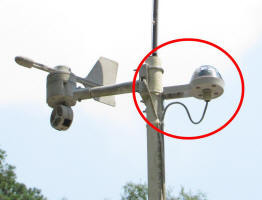
An RG-11 can measure rainfall in thousandths or even ten-thousands of an inch, where tipping buckets typically do not start indicating rainfall until after several hundredths of an inch have accumulate.
At last, a sensitive rugged, reliable, low-maintenance way to measure rainfall.
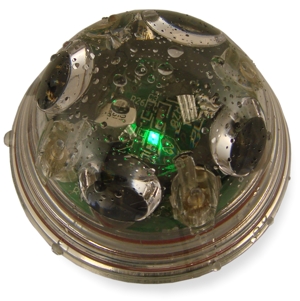
The RG-11 features an LED that lights whenever the output is active, helping with troubleshooting.
A mechanical tipping bucket works by gathering water into a large funnel, and filling a mechanical bucket that tips when the weight of the water reaches a threshold. This approach is simple, accurate, fragile, and high-maintenance. If you jostle a tipping bucket it will register it as rain, making them unsuitable for mobile applications. Debris can clog the collection funnel. They should be cleaned periodically, because the water and dust leave residue behind on the moving part. They do not start to register until enough rain has gathered on the funnel and filled the bucket– typically several hundredths of an inch.
In contrast, the RG-11 counts individual droplets. Thus, it is a hundred times more sensitive than a typical tipping bucket. Further, the RG-11 contains no moving parts. The RG-11 is unaffected by motion and the sensing surface is convex and self cleaning.
Accuracy and the RG-11
Not as accurate as a properly maintained Tipping Bucket, but a better choice for many applications.
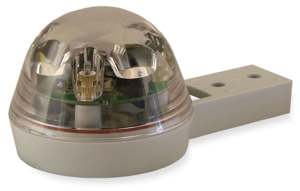
We do not guarantee or specify an accuracy for the RG-11, but these are the results we have seen for our three testing stations:
Cumulative Error for the three stations: -10% to -28%
Standard Deviation of error for each rain event: 36%
The standard deviation means that roughly 2/3 of the time the RG-11 will be within 36% of the tipping bucket. Much of the time the RG will read close to the tipping bucket, but outlier events can be significantly off.
Data taken between October 2011 and November 2012. Software revision – 12 (current is 16, but does not change accuracy). Units for testing range between new and three years of weathering and wear, including tests with intentionally scuffed / excessively worn units.
Snow melt is not included in the totals. Percent error for rain events is for events over 0.02" accumulation. (Tipping bucket does not register below about 0.02")
There is not a clear correlation of any readily measurable parameter. The biggest factor is surface condition.
A few notes:
- The RG-11 is great for qualitative measurements versus quantitative, i.e. you’ll know when there’s a heavy rain rather than a light mist but not an exact amount of rain.
- A tipping bucket will typically miss the first couple of hundreds of an inch of rain as the collecting funnel fills. The RG-11 starts totalizing right away, and is thus more accurate than a tipping bucket for small rainfall accumulations..
- If the tipping bucket mechanism gets stuck for any reason, the tipping bucket will not read at all. If the tipping bucket becomes clogged it may not read. The RG-11 is more accurate in these conditions.
- The RG-11 will generally not detect snow. A tipping bucket will read the snow after it melts.
- We know of no above-freezing condition that will cause the RG-11 to fail to detect rain.
- We know of no dry condition that will cause the RG-11 to falsely indicate rain.
The RG-11 is a great choice for:
- Applications where maintenance is difficult
- Marine or mobile rain sensing, where motion would make a tipping bucket not work.
- Sensing very small amounts of rain for data gathering and correlating to other factors
- Use in conjunction with tipping buckets to extend the range to small amounts, or for increased system reliability.
- Qualitative data gathering for applications such as erosion monitoring.
- Input for an irrigation system.
- input for process control.
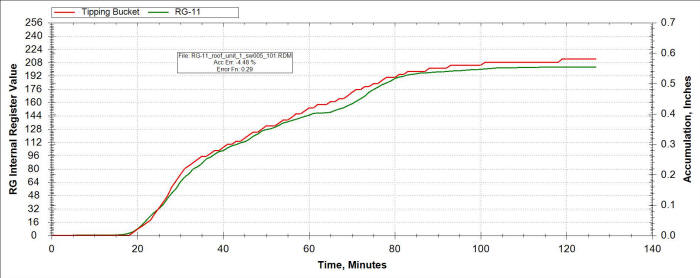
The above graph show the rainfall accumulation of an RG-11 (green line) and a reference tipping bucket (red line), during a rainstorm at our headquarters in Minnesota on October 22, 2010.
Make something happen when it first starts raining– or when it stops.
Do you have a process or device that needs to know that it is raining? The RG-11 produces an output that turns on when it is raining, and off when it stops. The sensor is extremely sensitive, and can be set to trigger on the first detected drop. Alternatively, the sensor may be set to turn-on at a rain intensity threshold. See theRG-11 instructions for details on setting the sensitivity.
Almost as useful, the RG-11 Rain Sensor opens the relay when the rainfall stops; it does not need to wait for the water to evaporate.
Other rain sensing technologies have serious drawbacks:
- Conductive sensors do not turn off until the water evaporates, and are prone to getting stuck on due to contaminants.
- Tipping buckets are bulky and fragile.
- Irrigation-style, absorbent disks require a lot of water to trip and stay on for days.
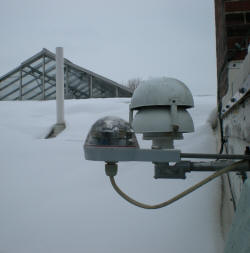
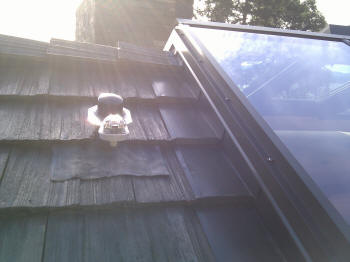
A Rain Gauge is used to control sky light windows
The RG-11 makes it easy for you to incorporate rain sensing into your system. None of the competing technologies make it easy to set an intensity threshold.
You can set the output to remain on for 15 minutes after the last rain has stopped. Use this, for example, in order to prevent equipment from constantly turning on and off or opening and closing during changing rain conditions.
Included especially for sun-shield awning control, the RG-11 Rain Sensor can also be set to trigger the output whenever it is dark.
Applications
The RG-11 is the perfect rain sensor for:
- Opening and closing skylights, vents, louvers, or windows.
- Process Control
- Retracting Awnings
- Enabling / Disabling equipment
- Data Collection
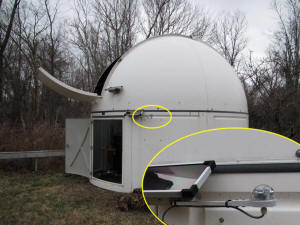
Our rain sensor (shown in detail in inset) deployed to close an astronomical observatory at the first detected raindrop. This solar-powered application takes advantage of the RG-11 micro-power mode.
